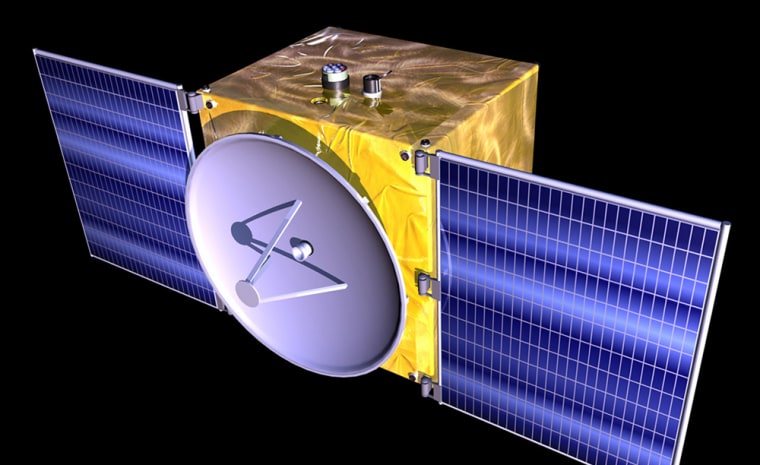Chances are that the asteroid Apophis will sail harmlessly past Earth in the year 2036 — but just in case, space engineers have developed a prize-winning plan for monitoring the potential cosmic hazard.
The Foresight mission concept was the big winner Tuesday in the Planetary Society's contest to encourage methods for monitoring Apophis, which is currently given a 1-in-45,000 chance of hitting Earth on April 13, 2036.
Scientists say they can't yet eliminate the threat entirely because they don't know Apophis' orbit precisely enough. That's what prompted the Planetary Society, a nonprofit space interest group based in California, to offer $50,000 in prizes for proposals to "tag" the asteroid during earlier encounters.
The top prize of $25,000 went to the Foresight team, led by Atlanta-based SpaceWorks Engineering in conjunction with California-based SpaceDev. SpaceWorks' Mark Schaffer was the team's prinicipal investigator.
In the student category, the $5,000 first-place prize went to the Georgia Institute of Technology. Engineering student Jonathan Sharma was the principal investigator for a mission design entitled Pharos.
NASA and the European Space Agency co-sponsored the competition and will review the mission designs, the Planetary Society said.
”We are very happy that this competition inspired innovative designs to solve an important problem that could affect life on Earth — as the dinosaurs learned the hard way,” Bruce Betts, the Planetary Society's director of projects, said in an announcement listing the winners. “We hope the winning entries will catalyze the world’s space agencies to move ahead with designs and missions to protect Earth from potentially dangerous asteroids and comets.”
To tag an asteroid
Although Apophis was used as the test case for the contest, the Planetary Society said the mission designs could be adapted to tag any potentially hazardous asteroid. Tagging would allow scientists to track the asteroid accurately enough to determine whether it will impact Earth, thus helping governments decide whether to mount a deflection mission to alter its orbit.
Slideshow 12 photos
Month in Space: January 2014
Apophis is a special case among near-Earth asteroids. In the year 2029, the space rock is expected to come as close as 18,300 miles (29,470 kilometers) to Earth. If the asteroid passes through a small "keyhole" in outer space during that encounter, Earth's gravitational pull could disturb Apophis' orbit and put it on a path to impact the planet on its next pass, in 2036.
Apophis is thought to measure about 820 feet (250 meters) across. Astronomers say that's not big enough to create a mass extinction like the one that wiped out the dinosaurs 65 million years ago, but probably big enough to devastate a region the size of Northern California if it landed in the wrong place.
Current observations haven't completely ruled out such a scenario, and the next best time to observe Apophis comes in 2013. If astronomers still can't rule out a collision after those observations, space officials would likely have to determine Apophis' orbit as precisely as possible. That's where the "tagging" concept could play a role.
Mission cost: $137 million
To keep mission costs low, the Foresight team proposed a simple orbiter with only two instruments and a radio beacon at a cost of $137.2 million. The spacecraft would launch aboard a Minotaur 4 rocket, leaving Earth by 2014, and arrive at Apophis five to 10 months later. It would then rendezvous with, observe, and track the asteroid.
Foresight would orbit the asteroid to gather data with a multispectral imager for one month. It would then leave orbit and fly in formation with Apophis around the sun at a range of 1.2 miles (2 kilometers). The spacecraft would use laser ranging to the asteroid and radio tracking from Earth for 10 months to determine the asteroid’s orbit and how it might change.
Pharos, the winning student entry, would be an orbiter with four science instruments (a multispectral imager, near-infrared spectrometer, laser rangefinder and magnetometer) that would rendezvous with and track Apophis. Earth-based tracking of the spacecraft would then allow precise tracking of the asteroid. The Pharos spacecraft would also carry four instrumented probes that it would launch individually over the course of two weeks. Accelerometers and temperature sensors on the probes would measure the seismic effects of successive probe impacts, to explore the interior structure and dynamics of the asteroid.
The competition received 37 mission proposals from 20 countries on six continents. International teams took the other prizes in the contest:
- The $10,000 second-place prize went to a European team led by Spain's Deimos Space S.L., in cooperation with EADS Astrium (Germany), the University of Stuttgart and the University of Pisa. The team won a second-place prize of $10,000 in the overall contest.
- The $5,000 third-place prize went to a team led by EADS Astrium Ltd. (United Kingdom), in conjunction with EADS Astrium SAS (France); IASF-Roma, INAF; Open University (U.K.); Rheinisches Institut für Umweltforschung (Germany); Royal Observatory of Belgium; and Italy's Telespazio.
- Australia's Monash University and the University of Michigan tied for second place in the student category. Each second-place team won $2,000.
- A team from Hong Kong Polytechnic University and Hong Kong University of Science and Technology received an honorable mention and $1,000 for the most innovative student proposal.
The $50,000 in prize money was contributed by the Planetary Society's chairman of the board, Dan Geraci. Additional funding to run the competition was provided by Planetary Society members.
This report was based on information from the Planetary Society.

